Eduard Jorswieck
6G Resilience -- White Paper
Sep 10, 2025Abstract:6G must be designed to withstand, adapt to, and evolve amid prolonged, complex disruptions. Mobile networks' shift from efficiency-first to sustainability-aware has motivated this white paper to assert that resilience is a primary design goal, alongside sustainability and efficiency, encompassing technology, architecture, and economics. We promote resilience by analysing dependencies between mobile networks and other critical systems, such as energy, transport, and emergency services, and illustrate how cascading failures spread through infrastructures. We formalise resilience using the 3R framework: reliability, robustness, resilience. Subsequently, we translate this into measurable capabilities: graceful degradation, situational awareness, rapid reconfiguration, and learning-driven improvement and recovery. Architecturally, we promote edge-native and locality-aware designs, open interfaces, and programmability to enable islanded operations, fallback modes, and multi-layer diversity (radio, compute, energy, timing). Key enablers include AI-native control loops with verifiable behaviour, zero-trust security rooted in hardware and supply-chain integrity, and networking techniques that prioritise critical traffic, time-sensitive flows, and inter-domain coordination. Resilience also has a techno-economic aspect: open platforms and high-quality complementors generate ecosystem externalities that enhance resilience while opening new markets. We identify nine business-model groups and several patterns aligned with the 3R objectives, and we outline governance and standardisation. This white paper serves as an initial step and catalyst for 6G resilience. It aims to inspire researchers, professionals, government officials, and the public, providing them with the essential components to understand and shape the development of 6G resilience.
A Scalable Machine Learning Approach Enabled RIS Optimization with Implicit Channel Estimation
Aug 10, 2025Abstract:The reconfigurable intelligent surface (RIS) is considered as a key enabler of the next-generation mobile radio systems. While attracting extensive interest from academia and industry due to its passive nature and low cost, scalability of RIS elements and requirement for channel state information (CSI) are two major difficulties for the RIS to become a reality. In this work, we introduce an unsupervised machine learning (ML) enabled optimization approach to configure the RIS. The dedicated neural network (NN) architecture RISnet is combined with an implicit channel estimation method. The RISnet learns to map from received pilot signals to RIS configuration directly without explicit channel estimation. Simulation results show that the proposed algorithm outperforms baselines significantly.
Energy Efficiency Optimization of Finite Block Length STAR-RIS-aided MU-MIMO Broadcast Channels
Jun 13, 2025Abstract:Energy-efficient designs are proposed for multi-user (MU) multiple-input multiple-output (MIMO) broadcast channels (BC), assisted by simultaneously transmitting and reflecting (STAR) reconfigurable intelligent surfaces (RIS) operating at finite block length (FBL). In particular, we maximize the sum energy efficiency (EE), showing that STAR-RIS can substantially enhance it. Our findings demonstrate that the gains of employing STAR-RIS increase when the codeword length and the maximum tolerable bit error rate decrease, meaning that a STAR-RIS is more energy efficient in a system with more stringent latency and reliability requirements.
A Framework for Fractional Matrix Programming Problems with Applications in FBL MU-MIMO
Feb 03, 2025Abstract:An efficient framework is conceived for fractional matrix programming (FMP) optimization problems (OPs) namely for minimization and maximization. In each generic OP, either the objective or the constraints are functions of multiple arbitrary continuous-domain fractional functions (FFs). This ensures the framework's versatility, enabling it to solve a broader range of OPs than classical FMP solvers, like Dinkelbach-based algorithms. Specifically, the generalized Dinkelbach algorithm can only solve multiple-ratio FMP problems. By contrast, our framework solves OPs associated with a sum or product of multiple FFs as the objective or constraint functions. Additionally, our framework provides a single-loop solution, while most FMP solvers require twin-loop algorithms. Many popular performance metrics of wireless communications are FFs. For instance, latency has a fractional structure, and minimizing the sum delay leads to an FMP problem. Moreover, the mean square error (MSE) and energy efficiency (EE) metrics have fractional structures. Thus, optimizing EE-related metrics such as the sum or geometric mean of EEs and enhancing the metrics related to spectral-versus-energy-efficiency tradeoff yield FMP problems. Furthermore, both the signal-to-interference-plus-noise ratio and the channel dispersion are FFs. In this paper, we also develop resource allocation schemes for multi-user multiple-input multiple-output (MU-MIMO) systems, using finite block length (FBL) coding, demonstrating attractive practical applications of FMP by optimizing the aforementioned metrics.
Rate Splitting Multiple Access for RIS-aided URLLC MIMO Broadcast Channels
Nov 17, 2024



Abstract:The performance of modern wireless communication systems is typically limited by interference. The impact of interference can be even more severe in ultra-reliable and low-latency communication (URLLC) use cases. A powerful tool for managing interference is rate splitting multiple access (RSMA), which encompasses many multiple-access technologies like non-orthogonal multiple access (NOMA), spatial division multiple access (SDMA), and broadcasting. Another effective technology to enhance the performance of URLLC systems and mitigate interference is constituted by reconfigurable intelligent surfaces (RISs). This paper develops RSMA schemes for multi-user multiple-input multiple-output (MIMO) RIS-aided broadcast channels (BCs) based on finite block length (FBL) coding. We show that RSMA and RISs can substantially improve the spectral efficiency (SE) and energy efficiency (EE) of MIMO RIS-aided URLLC systems. Additionally, the gain of employing RSMA and RISs noticeably increases when the reliability and latency constraints are more stringent. Furthermore, RISs impact RSMA differently, depending on the user load. If the system is underloaded, RISs are able to manage the interference sufficiently well, making the gains of RSMA small. However, when the user load is high, RISs and RSMA become synergetic.
URLLC Networks enabled by STAR-RIS, Rate Splitting, and Multiple Antennas
Nov 07, 2024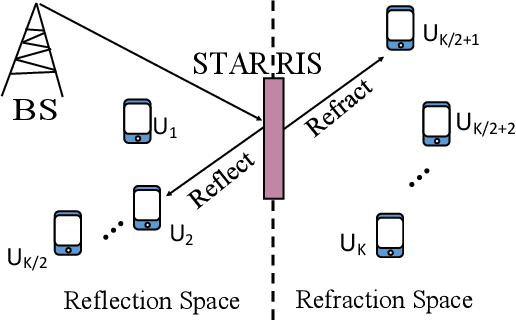
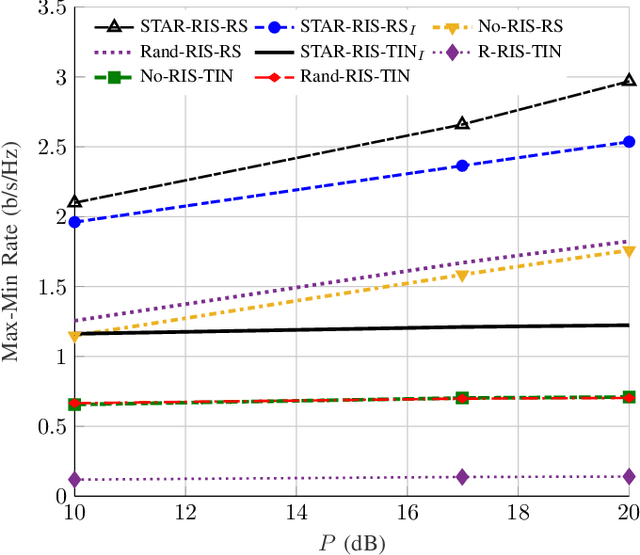
Abstract:The challenges in dense ultra-reliable low-latency communication networks to deliver the required service to multiple devices are addressed by three main technologies: multiple antennas at the base station (MISO), rate splitting multiple access (RSMA) with private and common message encoding, and simultaneously transmitting and reflecting reconfigurable intelligent surfaces (STAR-RIS). Careful resource allocation, encompassing beamforming and RIS optimization, is required to exploit the synergy between the three. We propose an alternating optimization-based algorithm, relying on minorization-maximization. Numerical results show that the achievable second-order max-min rates of the proposed scheme outperform the baselines significantly. MISO, RSMA, and STAR-RIS all contribute to enabling ultra-reliable low-latency communication (URLLC).
Rate Region of RIS-Aided URLLC Broadcast Channels: Diagonal versus Beyond Diagonal Globally Passive RIS
Oct 28, 2024
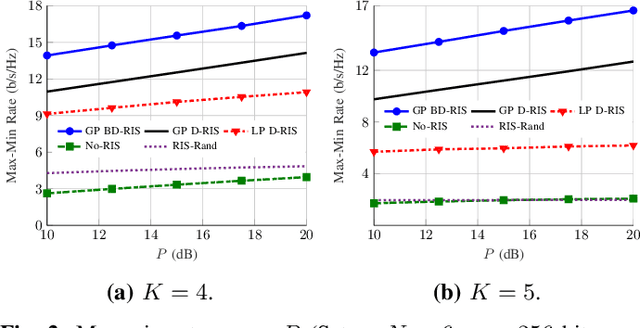
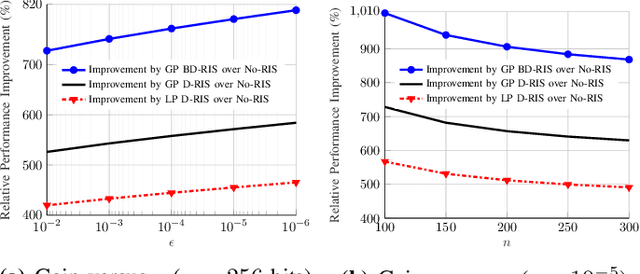
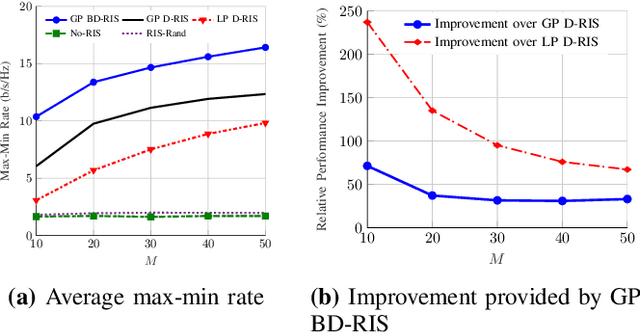
Abstract:We analyze the finite-block-length rate region of wireless systems aided by reconfigurable intelligent surfaces (RISs), employing treating interference as noise. We consider three nearly passive RIS architectures, including locally passive (LP) diagonal (D), globally passive (GP) D, and GP beyond diagonal (BD) RISs. In a GP RIS, the power constraint is applied globally to the whole surface, while some elements may amplify the incident signal locally. The considered RIS architectures provide substantial performance gains compared with systems operating without RIS. GP BD-RIS outperforms, at the price of increasing the complexity, LP and GP D-RIS as it enlarges the feasible set of allowed solutions. However, the gain provided by BD-RIS decreases with the number of RIS elements. Additionally, deploying RISs provides higher gains as the reliability/latency requirement becomes more stringent.
Energy Efficiency Comparison of RIS Architectures in MISO Broadcast Channels
Aug 08, 2024

Abstract:In this paper, we develop energy-efficient schemes for multi-user multiple-input single-output (MISO) broadcast channels (BCs), assisted by reconfigurable intelligent surfaces (RISs). To this end, we consider three architectures of RIS: locally passive diagonal (LP-D), globally passive diagonal (GP-D), and globally passive beyond diagonal (GP-BD). In a globally passive RIS, the power of the output signal of the RIS is not greater than its input power, but some RIS elements can amplify the signal. In a locally passive RIS, every element cannot amplify the incident signal. We show that these RIS architectures can substantially improve energy efficiency (EE) if the static power of the RIS elements is not too high. Moreover, GP-BD RIS, which has a higher complexity and static power than LP-D RIS and GP-D RIS, provides better spectral efficiency, but its EE performance highly depends on the static power consumption and may be worse than its diagonal counterparts.
MIMO Capacity Maximization with Beyond-Diagonal RIS
Jun 04, 2024



Abstract:This paper addresses the problem of maximizing the capacity of a multiple-input multiple-output (MIMO) link assisted by a beyond-diagonal reconfigurable intelligent surface (BD-RIS). We maximize the capacity by alternately optimizing the transmit covariance matrix, and the BD-RIS scattering matrix, which, according to network theory, should be unitary and symmetric. These constraints make the optimization of BD-RIS more challenging than that of diagonal RIS. To find a stationary point of the capacity we maximize a sequence of quadratic problems in the manifold of unitary matrices. This leads to an efficient algorithm that always improves the capacity obtained by a diagonal RIS. Through simulation examples, we study the capacity improvement provided by a passive BD-RIS architecture over the conventional RIS model in which the phase shift matrix is diagonal.
SLIPT in Joint Dimming Multi-LED OWC Systems with Rate Splitting Multiple Access
Feb 28, 2024Abstract:Optical wireless communication (OWC) systems with multiple light-emitting diodes (LEDs) have recently been explored to support energy-limited devices via simultaneous lightwave information and power transfer (SLIPT). The energy consumption, however, becomes considerable by increasing the number of incorporated LEDs. This paper proposes a joint dimming (JD) scheme that lowers the consumed power of a SLIPT-enabled OWC system by controlling the number of active LEDs. We further enhance the data rate of this system by utilizing rate splitting multiple access (RSMA). More specifically, we formulate a data rate maximization problem to optimize the beamforming design, LED selection and RSMA rate adaptation that guarantees the power budget of the OWC transmitter, as well as the quality-of-service (QoS) and an energy harvesting level for users. We propose a dynamic resource allocation solution based on proximal policy optimization (PPO) reinforcement learning. In simulations, the optimal dimming level is determined to initiate a trade-off between the data rate and power consumption. It is also verified that RSMA significantly improves the data rate.
 Add to Chrome
Add to Chrome Add to Firefox
Add to Firefox Add to Edge
Add to Edge